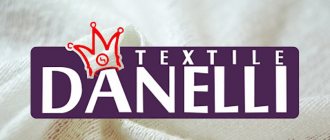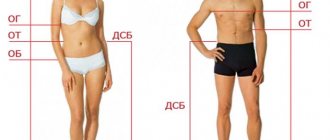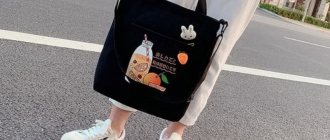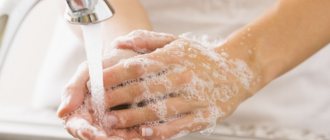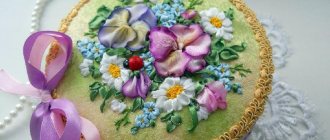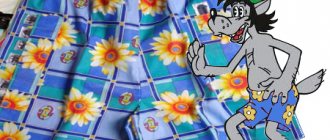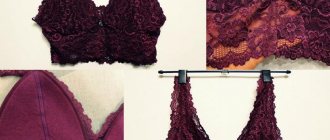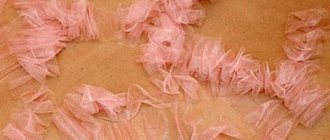Production
Interlining is not a fabric, it is a paper-like fiber. Made from viscose, sometimes with the addition of polyester, it has a fibrous composition. Based on modified cellulose fibers, a liquid carrier and additives, paper pulp is prepared, which is converted into the form of a long strip, pressed, glued (if necessary), and then dried. The finished canvas is rolled into rolls with a width of 30 to 150 cm. It can be painted or unpainted.
To make a formband, the resulting fabric is cut into oblique strips 12 mm wide, which are stitched with a chain stitch for greater strength, and wound onto a reel. Comes in white and black.
Features and properties of the material
This is a unique material that can be either on a regular basis or on an adhesive basis. But no matter what is used as a basis, the non-woven formband is always elastic, very thin and is able to quickly restore its original shape. In its production, ordinary non-woven fabric is used, which is cut into strips of a certain width. Since it is most often used at corners of the product, these stripes should be cut obliquely. Needlewomen often ask the question: what if you can’t find non-woven formband, what can you replace it with? You can take regular non-woven fabric and cut strips of the required width from it at an angle.
Kinds
Non-woven fabric can be non-removable (water-insoluble) or removable (water-soluble).
- The first serves to give the product strength and wear resistance during operation, and also helps to better keep its shape.
- The removable one is used only during the work process (sewing or embroidery); after all work is completed, the item is washed and the interlining simply dissolves.
It comes with or without adhesive.
- The glue layer can be continuous or dotted. This type of cushioning material is connected to the main one using a heated iron.
- Non-adhesive is applied to the part and pinned with needles so that it does not move during work.
For patchwork, quilts and other types of needlework, soft lambrequins and curtain grips, voluminous non-woven fabric is used. And what it is is very easy to determine by the name itself: it is a lightweight, bulky adhesive-based gasket.
Material care
It is better to store water-soluble non-woven fabric in a place protected from moisture, high temperatures and sunlight. This web instantly dissolves in water, and exposure to temperature can affect its structure.
Floral material requires protection from moisture. The floral non-woven web holds its shape perfectly only when dry.
The non-woven fabric included in the clothing does not require any special care. When using and caring for such items, you should take into account the type of main fabrics of the clothing.
Water-soluble smooth non-woven fabric is widely used in sewing, embroidery, patchwork and other types of needlework. Even such a field as floristry cannot do without it. Affordable prices, ease of manufacture and prevalence only increase its popularity.
Instructions for gluing non-woven dublerin from Alexander Timofeev:
Functions and scope of application
The main task of this material is to give the part or the entire product strength and wear resistance, as well as shape.
Formband is used for:
- strengthening of some parts of clothing: neckline, bottom of knitwear, shoulder seams, shelves, and other elements that are most subject to stress during operation. With it, the fabric will not stretch and sag. Easily fits along semicircular cuts (45 degree angle);
- easier sewing of very thin fabrics;
- embroidery with thread or beads. With its help, the fabric will not wrinkle, and the threads will be laid more tightly.
The stitched formband does not stretch, but retains its plasticity.
Read about: textiles for creating Korovlevsky design: Arben fabrics
Why do you need a water-soluble formband?
The peculiarities of the structure of cellulose make it possible, with certain processing, to form from them such fabrics that will be destroyed when heated or dissolved in water.
- The first of these seemingly undesirable properties allows fabric layers to be firmly and accurately glued together after ironing.
- As for the second, water-soluble interlining is a common basis for various types of embroidery. A corresponding design is applied to it, which can be embroidered directly onto this fabric. In this case, after washing the finished work, an elegant lace is obtained from interlacing threads, with the addition of beads or seed beads (of course, all the details of the ornament must be closed and connected to each other). In addition, a piece of fabric with an embroidery pattern can be attached using an iron to a finished dress or blouse.
Non-woven fabric will ensure the evenness of the fabric and will facilitate the execution of stitches of any type, helping to make them uniform. After embroidery, just wet the product in cold water and then iron it.
For embroidery, water-soluble formband is also used, from which you can make openwork stitching or ornamental stripes on other fabric. Another area of application for this translucent ribbon material is the creation of artificial flowers and various decorative elements. However, you need to remember that such compositions should be kept away from sunlight and protected from moisture.
Where can I buy
Formband is sold in any sewing store; you can buy the length you need (usually in meters) or a whole spool.
If you don’t have it in the store, you can take a regular non-woven fabric of the required density, cut it on the bias into 1.2 cm strips. At a distance of 4 mm from the edge of the strip, draw a thin line (along the entire length) and stitch it on a machine. Then work in the same way as with the finished tape.
Useful
The seam should be a chain (flat) seam with two or three needles, not a shuttle stitch. It can be done on a flat-stitch (cover-stitch) sewing machine or a coverlock machine, which has needles and a looper, not a shuttle. It turns out to be very durable and at the same time elastic, with parallel lines on one side and so-called loops on the other.
Types and applications
The widest scope of application of the described fabric is sewing clothes, ranging from evening dresses to raincoats. In this case, water-soluble material is not suitable.
Article on the topic: Knitted sneakers: diagram and description of a master class with video
For tailoring
Non-woven adhesive fabric is used to stabilize the shape of the neckline. Adhesive interlining is used to strengthen the edges of fronts, the bottom of knitwear and shoulder seams .
Depending on the color, the following types of non-woven fabric are distinguished: black and white. By density it is divided depending on the units: from 18 to 70. Eighteen units have the thinnest fabric - cobweb, characterized by pronounced transparency. The densest material is used in sewing outerwear and suits.
A double-sided water-soluble material is used to hold the two parts together. This sewing attribute is also useful for creating soft toys and educational accessories for children.
Creation
Formband is suitable for embroidery with beads, ribbons or threads. Thanks to its presence, the threads lie tightly and evenly on the fabric. At the same time, the fabric does not wrinkle. For bead embroidery, the use of non-woven strips is especially important: the fabric is compacted, and the product turns out beautiful and organic.
This canvas is fixed from below to the base. After finishing the work, the material can be easily removed without deforming the design. The composition of the fabric for strengthening bead embroidery includes only specific water-soluble material. Adhesive material is used in complex embroidery, in sewing - to secure stretchy fabric.
Non-woven fabric is an indispensable assistant for embroidery with beads or threads of any complexity and other types of handicrafts. Using a water-soluble type of non-woven fabric, you can create scarves and clothing of amazing beauty.
Floristics
Another type of non-woven material is floral, used, respectively, for decorating bouquets and flower arrangements. This is a web in the form of a chaotic interweaving of thin fibers. Although the composition contains only chemical components, the floral formband looks very natural and beautiful.
To strengthen coat and raincoat fabrics, a voluminous interlining was created, which includes three layers at once. The top and bottom are cobwebs with a high level of density. The middle of these layers creates volume. These types of materials have excellent thermal insulation characteristics.
Article on the topic: Application made of threads on cardboard on the theme of autumn with a master class and templates
So, interlining is a non-woven cushioning fabric. It is from this that formband strips are cut along an oblique line. Their width varies from 1.2 cm to 1.5 cm. Non-woven strips are sold in any sewing stores. You can also make it yourself.
Crazy-wool: how to replace water-soluble interlining
I really love the crazy -wool technique. I will not describe in this topic what it is, since there is a lot of information on this topic on the Internet. I will only say that in the last few years this topic has been developing very actively, although, as it turned out, few needlewomen (and especially not needlewomen) know about this magnificent technique.
When my daughter or I put on our dresses, tunics and scarves made using this technique, everyone looks around, examines them, the bravest ones come up and ask, asking to teach. Accordingly, they simply took off all the scarves from me, saying that I would still make them for myself, my beloved! Some of my friends, when they saw my very first dress for the first time, looked at it for a long time, stroked it, touched it... No felted clothing brought them such delight. The results are completely unique and incredible things. Truly unique! Truly for those who want to stand out!
Accordingly, they simply took off all the scarves from me, saying that I would still make them for myself, my beloved! Some of my friends, when they saw my very first dress for the first time, looked at it for a long time, stroked it, touched it... No felted clothing brought them such delight. The results are completely unique and incredible things. Truly unique! Truly for those who want to stand out!
So, the preface turned out to be a bit long. This is not what I wanted to talk about.
I have often been asked and continue to ask what can be used to replace water-soluble interlining , which cannot be bought everywhere (not counting the Internet), and is also quite expensive in price.
1. There is also a water-soluble film for embroidery, available in 10, 20, 30 and 40 microns. It is most convenient (as it seemed to me) to use 20-30 microns. It, like non-woven fabric, dissolves in water (the warmer it is, the faster). However, its advantage over non-woven fabric is obvious - it is transparent, you can select threads to match (sometimes the pattern requires constant changing of threads so that they are less visible), or you can stitch directly along the thread - then the lines will not be visible at all.
2. You can use newspapers. Technology: lay newspaper down, lay out threads on it, put newspaper on top again, iron it, baste it with large stitches and quilt it on a machine. Then the most difficult and painstaking work begins - picking out newspapers. The only thing is that after ironing they come out much easier! So be sure to iron before basting!
3. You can use tracing paper. It is denser than newspapers, but is easier to pick out.
4. An option with wallpaper glue or paste is possible. Technology: take a plastic film, lay threads on it, then a mesh (tulle or mosquito net), then cover everything with wallpaper glue or paste, preferably with a roller. The glue is prepared as usual (written on the package). I don’t recommend using this method, as it clogs up the machines a lot—they have to be disassembled and cleaned often. I feel sorry for mine.
5. Using the same technology as using glue, you can use a gelatin solution. I set it up like this: for 5 glasses of water (about 1 liter) I take about 35-40 grams of gelatin. First, I soak the gelatin, it swells, then I heat it without bringing it to a boil, I cool it a little and it can be applied with a roller to threads covered with tulle. Below is the film. The only thing I liked more is that I almost immediately remove the tulle and cover it again with film, then put on something heavy (like a press). I leave it overnight (sometimes it doesn’t have time to dry). If both sides are covered with film, after removal, a completely smooth and even surface remains, like a glossy one, with no threads sticking out. After removing the mesh, the surface is more shaggy, some threads stick out (which makes stitching on the machine somewhat difficult).
6. The last idea (perhaps it’s not the last) was given to me by one girl who does embroidery (and I don’t know where she got it from. We take paper towels (the thinnest, cheapest ones), apply a gelatin solution (about 40 g per 1 liter water), on an absolutely flat and clean surface (for me it’s a piece of plexiglass that lay on my table when I was at school, and then stood on the balcony as it was unnecessary), put a towel (paper), coat it with gelatin; then with We also place the other side on the edge closer to the radiator and leave it to dry. I applied it with a brush, a sponge (for washing dishes) and a roller. The most convenient way to use a sponge, as it seemed to me, is to use a blotting motion, otherwise the towel will tear. You can immediately make a stock of such towels and store them in an ordinary roll. Do not forget to wash this surface after each preparation of such hand-made non-woven fabric, otherwise the towel will subsequently stick and come off with holes, which is not good. Then you can use this “non-woven fabric” for its intended purpose. With the crazy-wool technique, it will be enough to simply soak it in warm water with shampoo and then rinse well. Both gelatin and paper towel can be washed off well with water.
When used in embroidery, you can glue such interlining - just iron it with an iron and steam. This is an option for use in decoupage of fabrics (imagine what beauty can be created with decoupage garden flowers, mmm...). I hope my information is useful to you. At one time, I collected it bit by bit, looked for it, asked. Now I can advise others on my proven advice! 
Non-woven formband - water-soluble adhesive fabric in photo
Formband interlining is a water-soluble adhesive fabric in photographs.
In fact, non-woven formband is not an independent fabric, or even a variety of it. The basis for it is adhesive interlining; it is from this that strips are cut, turning into an excellent fixation for the neck.
Origin story
Answering the question of what non-woven fabric is, you can understand the history of its origin. This is not fabric at all, but a paper-like interlining fabric. But it so happened that water-soluble non-woven formband is usually called fabric due to its widespread use in sewing clothes, for beading and cross stitching.
The fibers that make up the non-woven formband appeared in the last century. For the first time they began to be manufactured at German enterprises. In the domestic industry, non-woven formband appeared at the end of the 20th century, and became widespread in the last decade.
Composition and properties
. It is obtained by cutting ordinary non-woven fabric along the bias into strips 12 mm wide.
This fabric contains chemically modified fibers. Despite its thinness, formband interlining perfectly strengthens the fabric and prevents it from deforming, curling, or crumbling. This characteristic is the most important.
Water-soluble non-woven fabric is very durable, has good abrasion resistance and is wear-resistant. It does not absorb liquid well. The fabric does not get dirty from its use.
In sewing and for embroidery with beads, sequins and beads, the material is used due to its amazing ability to maintain shape.
Types and applications
The widest scope of application of the described fabric is sewing clothes, ranging from evening dresses to raincoats. In this case, water-soluble material is not suitable.
For tailoring
Non-woven adhesive fabric is used to stabilize the shape of the neckline. .
Depending on the color, the following types of non-woven fabric are distinguished: black and white. By density it is divided depending on the units: from 18 to 70. Eighteen units have the thinnest fabric - cobweb, characterized by pronounced transparency. The densest material is used in sewing outerwear and suits.
A double-sided water-soluble material is used to hold the two parts together. This sewing attribute is also useful for creating soft toys and educational accessories for children.
Creation
Formband is suitable for embroidery with beads, ribbons or threads. Thanks to its presence, the threads lie tightly and evenly on the fabric. At the same time, the fabric does not wrinkle. For bead embroidery, the use of non-woven strips is especially important: the fabric is compacted, and the product turns out beautiful and organic.
This canvas is fixed from below to the base. After finishing the work, the material can be easily removed without deforming the design. The composition of the fabric for strengthening bead embroidery includes only specific water-soluble material. Adhesive material is used in complex embroidery, in sewing - to secure stretchy fabric.
Non-woven fabric is an indispensable assistant for embroidery with beads or threads of any complexity and other types of handicrafts. Using a water-soluble type of non-woven fabric, you can create scarves and clothing of amazing beauty.
Floristics
Another type of non-woven material is floral, used, respectively, for decorating bouquets and flower arrangements. This is a web in the form of a chaotic interweaving of thin fibers. Although the composition contains only chemical components, the floral formband looks very natural and beautiful.
To strengthen coat and raincoat fabrics, a voluminous interlining was created, which includes three layers at once. The top and bottom are cobwebs with a high level of density. The middle of these layers creates volume. These types of materials have excellent thermal insulation characteristics.
So, interlining is a non-woven cushioning fabric. It is from this that formband strips are cut along an oblique line. Their width varies from 1.2 cm to 1.5 cm.
Non-woven strips are sold in any sewing stores. You can also make it yourself.
Material care
It is better to store water-soluble non-woven fabric in a place protected from moisture, high temperatures and sunlight. This web instantly dissolves in water, and exposure to temperature can affect its structure.
Floral material requires protection from moisture. The floral non-woven web holds its shape perfectly only when dry.
The non-woven fabric included in the clothing does not require any special care. When using and caring for such items, you should take into account the type of main fabrics of the clothing.
Water-soluble smooth non-woven fabric is widely used in sewing, embroidery, patchwork and other types of needlework. Even such a field as floristry cannot do without it. Affordable prices, ease of manufacture and prevalence only increase its popularity.
Instructions for gluing non-woven dublerin from Alexander Timofeev:
You may also like
DIY tote bag
05.25.2018Anastasia Prozheva0
DIY camera case
05/16/2018Anastasia Prozheva0
Crochet amigurumi rabbits
06/10/2018Anastasia Prozheva0
Add a comment Cancel reply
Review Formband interlining is a water-soluble adhesive fabric.
Did you like the post? Share it with your friends!
